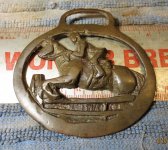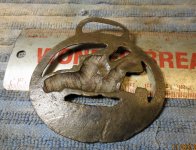cambria09
Bronze Member
- Jun 10, 2012
- 1,838
- 3,840
- Detector(s) used
- Mine Lab Sovereign Elite, Mine Lab Etrac, Garrett ATMax
- Primary Interest:
- All Treasure Hunting
Hello All. Found this at an empty lot near the FL Space Coast where we have found coins back to the 1890's.
My wife says it's an Equestrian Medal awarded back in the day. I am thinking she is wrong (first time ever) and it is some sort of saddle or horse tack adornment.
It is heavy brass, the main oval is about 2.5 x 3-IN, with no engraving to be found, and it looks rubbed down on the horse and rider side.
Please let me know if it looks familiar and thanks for the view. Good Luck out there. C9
My wife says it's an Equestrian Medal awarded back in the day. I am thinking she is wrong (first time ever) and it is some sort of saddle or horse tack adornment.
It is heavy brass, the main oval is about 2.5 x 3-IN, with no engraving to be found, and it looks rubbed down on the horse and rider side.
Please let me know if it looks familiar and thanks for the view. Good Luck out there. C9


















